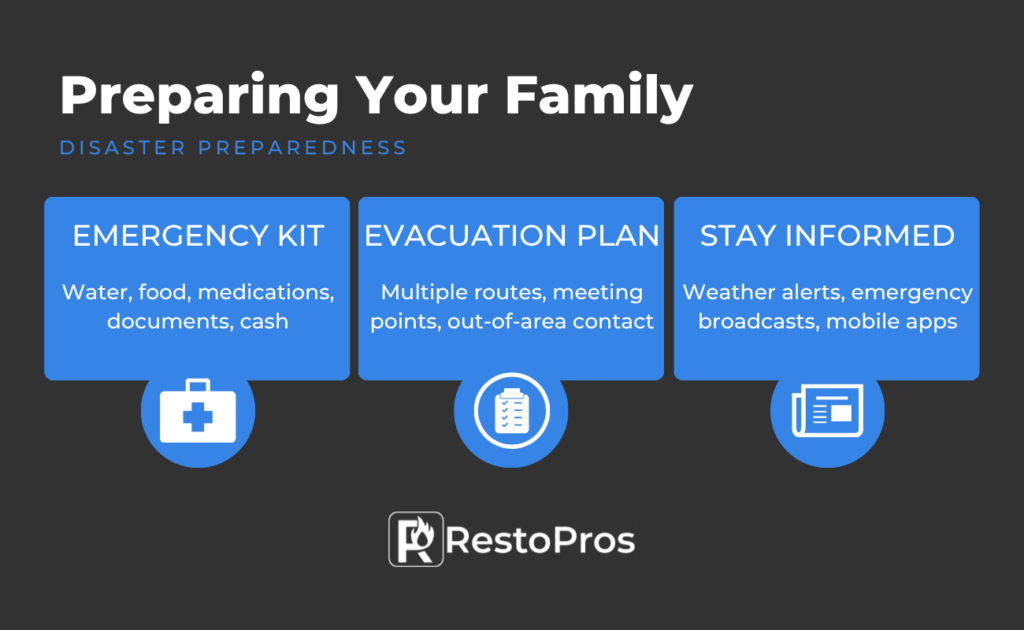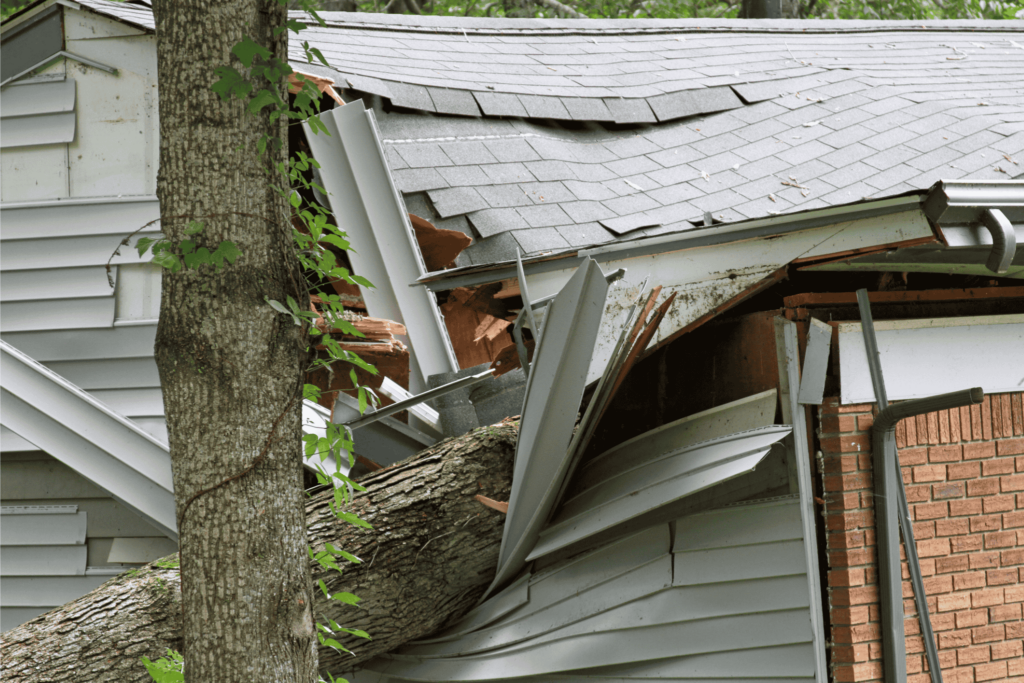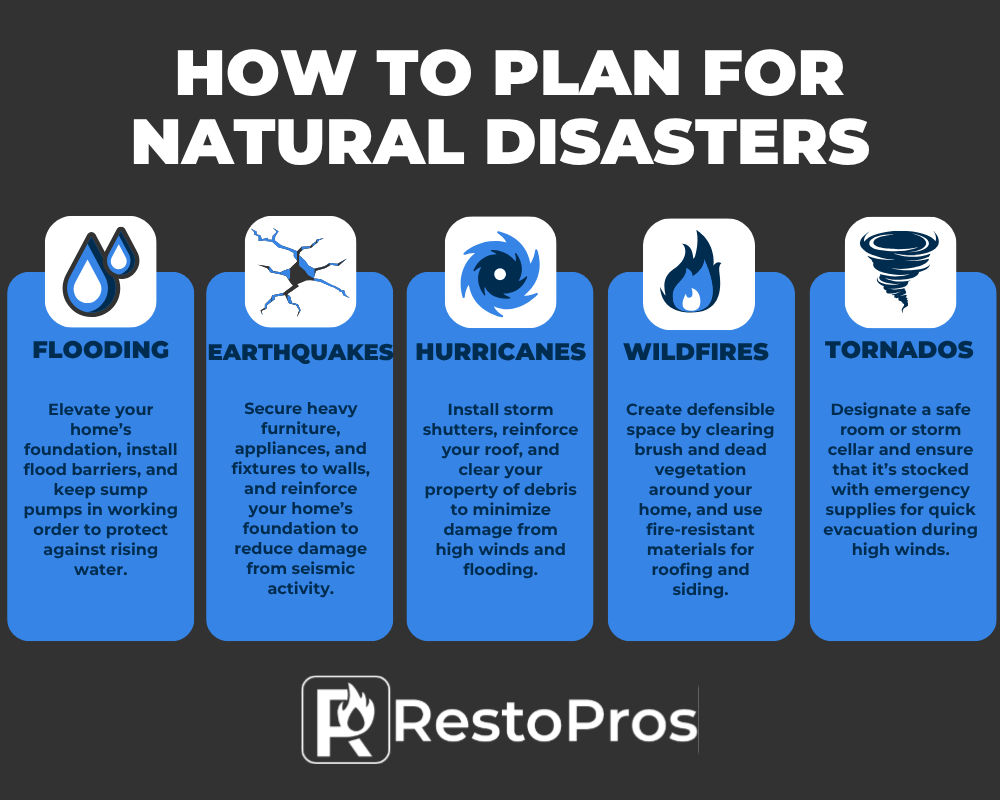When a natural disaster strikes, the difference between safety and tragedy often comes down to preparation. Whether it’s the destructive winds of a hurricane, the sudden surge of floodwaters, or the advancing wall of a wildfire, these forces of nature give little warning and show no mercy. But when the unexpected hits, RestoPros is here to help you prepare, respond, and recover.
Every year, thousands of families are caught off guard by disasters, facing devastating losses that could have been prevented with proper planning.
As disaster restoration specialists, RestoPros helps homeowners recover after nature takes its toll. We understand how overwhelming it can be to face the destruction left behind, from water damage and mold to fire and storm debris. That’s why we act fast—bringing in the tools, technicians, and experience needed to restore your home and give your family peace of mind. We’ve helped countless families rebuild after disaster, and we’re ready to help you too.
While this guide focuses on how to prepare before disaster strikes, remember: if the worst happens, you won’t have to face the aftermath alone. RestoPros is here to help you recover—quickly, safely, and with care.
Identify Potential Risks and Assess Your Home’s Vulnerabilities
The first step in disaster preparedness is understanding the specific risks in your area. Different regions face different threats, and identifying these risks allows you to focus your efforts where they’ll have the most impact.
Start by researching local hazards. Use resources such as FEMA (Federal Emergency Management Agency), NOAA (National Oceanic and Atmospheric Administration), and your local emergency management offices to understand the most common disasters in your region—whether it’s hurricanes, flooding, tornados, or wildfires.
Your region’s climate plays a big role in the types of disasters you might face. For example, if you live in an area prone to hurricanes, make sure you’re prepared for high winds and flood water. For those in wildfire-prone areas, it’s essential to clear brush and create a defensible space around your home. Understanding the specific threats in your area allows you to take the necessary steps to protect your property.
Secure & Strengthen Your Home: Protect Against the Elements
Securing your home is one of the most effective ways to prepare for a natural disaster. By reinforcing key areas, you can minimize potential damage and give your family better protection.
Structural Considerations
Start with reinforcing your roof. High winds can lift a poorly secured roof, so it’s important to make sure it’s properly reinforced. Installing storm shutters is essential, especially if you’re in a hurricane zone. These protect your windows and doors from flying debris. Impact-resistant windows and doors are a great investment in areas prone to severe storms.
Landscaping Considerations
Regularly trim trees, remove dead branches, and clear gutters and drains to prevent water damage during heavy rain. Trees and branches can become projectiles in high winds, so ensuring they are well-maintained can make a big difference. If you live in a wildfire-prone area, it’s important to maintain a defensible space by clearing brush and other flammable materials around your home.
Flooding Considerations
If you live in a flood-prone area, consider elevating your home or installing flood barriers to protect the foundation. Ensure your sump pumps are functional and have a backup power source to keep them running during power outages.
Earthquake Considerations
If you’re in an earthquake zone, securing heavy furniture and appliances to the walls is crucial to prevent tipping. You might also want to retrofit your home’s foundation to ensure it can handle the shaking.
Hurricane Considerations
For hurricane-prone areas, storm shutters are a must, and reinforcing the roof with roof straps helps prevent uplift during high winds.
Wildfire Considerations
Clear brush, leaves, and other flammable materials from around your home. Also, consider using fire-resistant materials for your roofing and siding.
Tornado Considerations
If you live in a tornado-prone area, ensure that your home has an emergency shelter or storm cellar and reinforce exterior walls to minimize damage during high winds.
Backup Power
Power outages during natural disasters are common. Installing a generator will ensure you have electricity when you need it most. Regularly maintaining the generator ensures it’s ready for use when necessary.
Insurance Coverage Review
It’s important to review your homeowners insurance policy to ensure it covers natural disasters like floods, hurricanes, and wildfires. Many policies don’t include flood damage, so you might need additional coverage if you’re in a high-risk area. Keep you policy with you and have all updated contact information.
 Create an Emergency Plan for Your Family
Create an Emergency Plan for Your Family
Having a family emergency plan in place ensures that everyone knows exactly what to do when a disaster strikes. This plan will reduce stress and confusion during a critical time and help your family stay safe. Designate a safe meeting place outside your home where everyone can gather in case of evacuation. Everyone in your family must know how to reach that location, whether by car or on foot.
Consider Unique Needs/Challenges
If any family members need extra assistance—whether they have medical conditions, mobility issues, or are elderly—make sure their needs are factored into your plan. Don’t forget your pets, either. Be sure to include them in your evacuation and shelter plans.
Build an Evacuation Plan
Map out several evacuation routes in case one is blocked by debris, flooding, or other hazards. Practice these routes with your family regularly, so everyone is familiar with where to go in an emergency. Each type of disaster may require different evacuation routes—whether it’s from flooding, wildfire, or a hurricane—so plan accordingly.
Assemble Your Emergency Kit: Be Ready for Anything
An emergency kit is essential for surviving a disaster. Having a well-stocked emergency supply ensures that you have everything you need to stay safe and comfortable when disaster strikes.
Your kit should include essentials like bottled water (one gallon per person per day for at least three days), non-perishable food, a flashlight, extra batteries, and a first-aid kit. These items will keep you going in case you’re stranded or forced to shelter in place.
In addition to these basics, include important documents in a waterproof container—copies of your ID, insurance policies, and medical records. This is crucial if you need to evacuate quickly and need proof of identity or insurance.
Medications and medical supplies should be included in your kit. Make sure you have enough prescription medications to last at least a week, and pack any over-the-counter items that your family may need.
Other essentials include cash (in case of power outages), hygiene products, and clothing. Having these items ensures you won’t be left scrambling for necessities when you need them most.
Stay Informed: Monitor Alerts and Weather Reports
Staying informed is key to making quick, effective decisions during a disaster. The more you know, the better equipped you are to respond appropriately.
Sign Up for Emergency Alerts
Local emergency alert systems provide real-time notifications on weather conditions, evacuations, and other emergencies. Sign up for these alerts to receive timely updates during disasters.
Monitor Weather Reports
Regularly check weather reports and hurricane watches, especially during hurricane season or periods of extreme weather. Make sure you know if severe weather is coming so you can take the necessary precautions in advance. FEMA, NOAA, and local news outlets are reliable sources of information during an emergency. They provide critical updates on everything from evacuations to shelter locations and road closures.
 Trust RestoPros When Disaster Strikes
Trust RestoPros When Disaster Strikes
Emergency preparedness is crucial, but even the most carefully laid plans can’t always prevent damage. Hurricanes, wildfires, floods, and storms can leave behind widespread destruction in a matter of hours. When that happens, you need more than cleanup. You need a team that understands the urgency, the emotions, and the complexity of putting your life back together. That’s where RestoPros comes in.
With years of hands-on experience in disaster restoration, RestoPros is your trusted partner in the recovery process. We know what it takes to restore not just structures, but peace of mind. From the moment you contact us, our team moves quickly to assess the damage, secure your property, and begin the restoration process. We’re available 24/7 to respond to emergencies, so you’re never left waiting when every second counts.
Here’s how we help after disaster strikes:
Water Damage: From flooding to burst pipes, our technicians use professional-grade equipment to extract water, dry structures, and prevent mold growth.
Fire Recovery: We address both visible damage and hidden smoke residue, removing soot, eliminating odors, and restoring affected structures and belongings.
Storm Damage: When severe weather strikes, count on us for emergency board-up, roof tarping, and comprehensive rebuilding services.
When disaster turns your world upside down, we’re not just restoring your house—we’re helping rebuild the place your family calls home.

